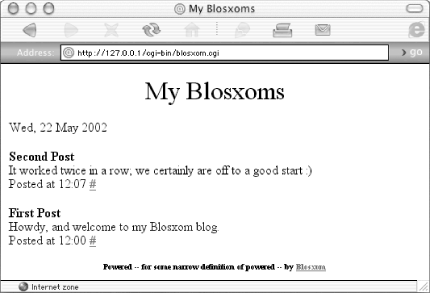Viewing Your Blog
Point your web browser at the Blosxom CGI script. If you’re running Blosxom on your local machine, the URL will probably be something like: http://localhost/cgi-bin/blosxom.cgi/. On a service provider’s web server, you’ll most likely find Blosxom at http://www.myprovider.com/~sam/cgi-bin/blosxom.cgi/, where myprovider.com is your provider’s domain and sam is your username.
If all goes as planned, you should see something along the lines of Figure 9-1, your first two blog entries in Blosxom’s default look and feel — such as it is.

Figure 9-1. Viewing your blog
Each day begins with the date, followed by weblog entries for that day in reverse-chronological order — the latest entries rise to the top. Each entry consists of a title, body, time of posting, and a permalink (the # bit) to the entry itself for easy reference.
The look and feel is completely customizable (see Section 9.10 later in this chapter).
The Archives
Of course, pointing at your weblog’s URL provides only the latest view with only the last few postings. Blosxom provides automatic virtual archives for your posts as well.
Appending a slash, the four-digit year, another slash, and the
three-letter month abbreviation or two-digit month number transports
you back to a particular month. For example, appending
/2002/May displays only entries for May 2002,
/1999/01 those for January 1999.
Appending to the month ...
Get Essential Blogging now with the O’Reilly learning platform.
O’Reilly members experience books, live events, courses curated by job role, and more from O’Reilly and nearly 200 top publishers.

